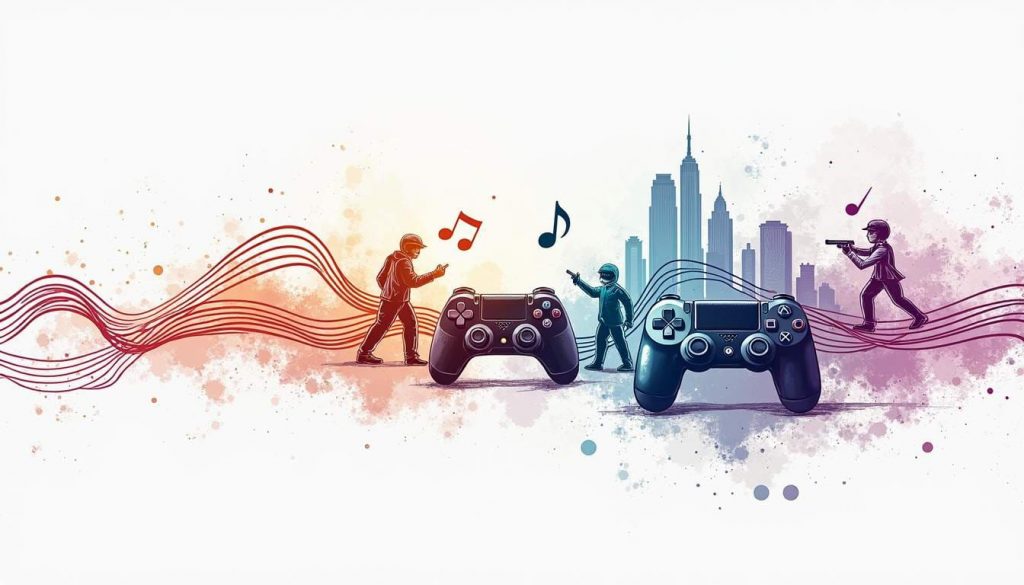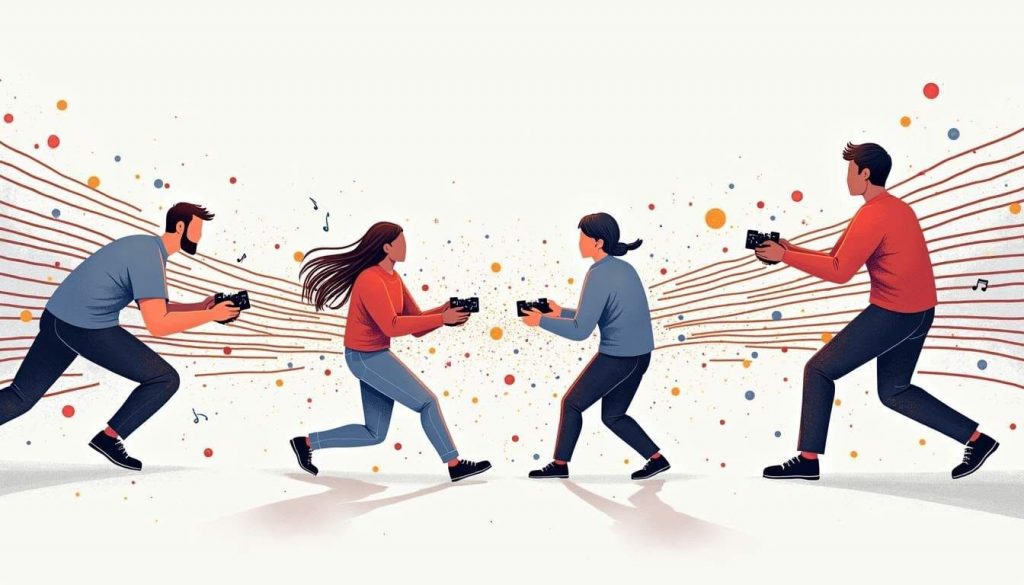Are you struggling to implement dynamic music in your game? You’re not alone. Game music synchronisation can make or break player immersion, but getting it right is more complex than simply playing background tracks. In this comprehensive guide, we’ll explore proven techniques for creating responsive, seamless music systems in your games. Whether you’re developing your first game or leading an established studio, partnering with an experienced game music composer will elevate your project from good to extraordinary through tailored, interactive musical scoring that resonates with your target audience.

1. Adaptive Music Implementation: Beyond Basic Background Tracks
The key to engaging game music lies in its responsiveness to player actions. Modern games require music systems that dynamically adapt to gameplay states, and implementing this requires careful architecture planning.
Building Your Music State System
Start by mapping out your game’s emotional states and intensity levels. Your music system should track:
- Combat intensity
- Exploration states
- Dialogue moments
- Environmental conditions
- Player health/status
Create clear transitions between these states to maintain musical coherence. For example, when transitioning from exploration to combat, your system should smoothly cross-fade between tracks while maintaining rhythmic synchronisation.
Layered Music Architecture
Rather than using single tracks, implement a layered system where multiple stems play simultaneously. This approach offers:
- Greater flexibility in musical transitions
- More nuanced emotional expression
- Better performance management
- Reduced memory footprint through asset reuse
Think of your music as a stack of complementary layers that can be mixed in real-time based on gameplay conditions. Each layer should be designed to work both independently and as part of the full arrangement.
For example, a serene exploration theme might be accompanied by subtle ambient sounds, such as birds chirping or water flowing, which can be gradually introduced or removed based on the player’s actions. This technique not only adds depth to the sound design but also helps to maintain player engagement by providing a constantly evolving auditory backdrop. Furthermore, layered soundtracks can be used to signify changes in gameplay, such as transitioning from exploration to combat, thereby guiding the player’s emotional response and enhancing the overall experience.
2. Technical Implementation Strategies
Memory Management
One of the biggest challenges in game music implementation is managing memory efficiently. Consider these strategies:
- Stream high-quality layers for crucial gameplay moments
- Use lower quality compression for ambient layers
- Implement dynamic loading/unloading of music assets
- Cache frequently used transition segments
Event System Architecture
Your event system needs to handle multiple simultaneous triggers while maintaining musical coherence. Key considerations include:
- Priority queue for musical events
- Buffer management for smooth transitions
- State machine design for complex musical behaviors
- Latency compensation techniques

3. The Importance of Timing
Timing is everything in music synchronisation. The right music at the right moment can elevate a gaming experience, while poor timing can disrupt immersion and engagement. The synchronisation of music with gameplay events requires careful planning and execution, as even slight misalignments can detract from the overall experience. Developers must consider not only the tempo and rhythm of the music but also the pacing of the gameplay itself. This intricate dance between music and action is what ultimately creates a cohesive and engaging experience for players.
Beat Matching
Beat matching involves aligning music tempo with gameplay events. This technique is particularly effective in rhythm-based games, where precise timing is essential for player success. In these games, the music serves as both a guide and a challenge, as players must synchronise their actions with the beat to achieve success. The use of beat matching can also enhance the emotional impact of key moments in a game, such as a climactic battle or a dramatic reveal. By carefully crafting the music to align with gameplay events, developers can create a sense of urgency and excitement that keeps players on the edge of their seats. Additionally, beat matching can be employed in non-rhythm games to enhance the overall pacing and flow, ensuring that players remain engaged and invested in the experience.
Maintaining rhythmic consistency during transitions is crucial for musical coherence. Implement these features:
- Beat detection system for transition points
- Tempo matching between musical segments
- Quantised transition timing
- Flexible time stretching capabilities
Event Triggers
Event triggers are used to synchronise music with specific in-game actions or events. For example, a triumphant score might play upon completing a level, reinforcing the player’s sense of achievement. These triggers can be programmed to activate at precise moments, ensuring that the music aligns perfectly with the gameplay. This technique can also be used to create tension and anticipation, as players await the resolution of a challenging encounter. By carefully timing musical cues, developers can enhance the emotional weight of key moments, making them more impactful and memorable. Furthermore, event triggers can be utilised to signal changes in gameplay dynamics, such as the introduction of a new enemy or a shift in the narrative, helping to guide the player’s experience and maintain engagement.
5. Collaborating with Game Composers
Successful music synchronisation often involves close collaboration between game developers and game composers. This partnership ensures that the music aligns with the game’s vision and enhances the overall experience. The collaborative process can take many forms, from brainstorming sessions to iterative feedback loops, and it is essential for both parties to communicate openly and effectively. By fostering a strong working relationship, developers and composers can create a cohesive audio experience that resonates with players and elevates the game’s narrative.
Creative Collaboration
Game Composers and developers must work together to create a cohesive audio experience. This involves sharing ideas, providing feedback, and iterating on compositions to achieve the desired effect. The creative collaboration process can be enriched by involving other team members, such as sound designers and narrative writers, to ensure that the music complements all aspects of the game. By fostering an environment of collaboration, developers can tap into the diverse skill sets and perspectives of their team, leading to innovative solutions and unique musical experiences. Additionally, regular playtesting sessions can provide valuable insights into how the music interacts with gameplay, allowing for further refinement and enhancement of the audio experience. This iterative approach not only strengthens the final product but also fosters a sense of ownership and pride among team members, as they see their contributions come to life in the game.
Technical Integration
Beyond creativity, technical integration is crucial. Game composers must understand the game’s sound engine and technical limitations to ensure seamless synchronisation and optimal performance. This requires a deep understanding of the tools and technologies used in game development, as well as the ability to adapt compositions to fit within these constraints. For example, composers may need to create multiple versions of a track to accommodate different gameplay scenarios or to ensure that the music can be dynamically adjusted based on player actions. Additionally, the integration of music with other audio elements, such as sound effects and voice acting, requires careful consideration to avoid clashes and ensure a harmonious overall soundscape. By prioritising technical integration, developers can create a polished audio experience that enhances the player’s immersion and enjoyment.
6. Challenges in Music Synchronisation
Despite its importance, music synchronisation in games presents several challenges. From technical constraints to creative differences, developers must navigate a complex landscape to achieve success. These challenges can arise at any stage of the development process, from initial concept to final implementation, and addressing them requires a combination of creativity, technical expertise, and effective communication.

Technical Constraints
Technical constraints, such as limited memory and processing power, can impact the quality and complexity of game music. Developers must find innovative solutions to overcome these limitations and deliver a high-quality audio experience. For instance, the use of streaming audio can allow for larger, more complex compositions to be integrated into a game without overwhelming system resources. Additionally, developers may need to optimise audio files to ensure that they load quickly and play smoothly, which can involve compressing files or using specific audio formats. These technical considerations are essential for maintaining a seamless gaming experience, as any lag or stuttering in the audio can disrupt immersion and detract from the overall enjoyment of the game. By proactively addressing technical constraints, developers can create a more polished and engaging audio experience that enhances the player’s journey.
Creative Differences
Creative differences between composers and developers can also pose challenges. Clear communication and collaboration are essential to ensure that the music aligns with the game’s vision and enhances the player experience. These differences can stem from varying artistic perspectives, differing priorities, or even misunderstandings about the game’s direction. To mitigate these challenges, it is crucial for both parties to establish a shared vision for the game’s audio experience from the outset. Regular check-ins and feedback sessions can help to ensure that everyone is on the same page and that any potential issues are addressed early in the process. By fostering an environment of open communication and collaboration, developers can navigate creative differences and create a cohesive audio experience that resonates with players.
7. The Future of Music in Games
As technology continues to advance, the future of music in games holds exciting possibilities. From virtual reality to AI-driven compositions, the potential for innovation is limitless. As developers explore new technologies and creative approaches, the role of music in games is likely to evolve, leading to even more immersive and engaging experiences for players. The integration of music with emerging technologies will open up new avenues for storytelling and gameplay, allowing for a more dynamic and responsive audio experience.

Virtual Reality
Virtual reality presents new opportunities for music synchronisation, as players become fully immersed in the game world. This requires innovative approaches to audio design and synchronisation to enhance the VR experience. In a VR environment, sound can be spatially positioned to create a more realistic and immersive experience, allowing players to perceive audio cues from different directions. This spatial audio technology can be used to enhance gameplay by providing players with auditory feedback that corresponds to their movements and actions within the virtual space. For example, the sound of footsteps might change based on the surface the player is walking on, or the music might shift in intensity as the player approaches a significant event. By leveraging the unique capabilities of VR, developers can create a more engaging and immersive audio experience that enhances the overall gameplay.
8. Case Studies and Examples
To illustrate the principles of music synchronisation, let’s explore some notable examples from the gaming industry. These case studies highlight the creative and technical achievements that have shaped the art of game music. By examining these examples, we can gain insights into the innovative techniques and approaches that have been employed to create memorable and impactful audio experiences.
The Legend of Zelda: Breath of the Wild
The Legend of Zelda: Breath of the Wild is renowned for its dynamic soundtrack, which adapts to the player’s actions and environment. This creates a seamless and immersive experience, enhancing the game’s open-world exploration. The music shifts in response to the player’s actions, with subtle changes that reflect the current situation, whether it be a peaceful moment in nature or an intense battle with enemies. This adaptive approach not only enhances the emotional impact of the game but also reinforces the player’s sense of agency and immersion. The use of environmental sounds, such as rustling leaves and flowing water, further enriches the auditory experience, creating a living, breathing world which players can lose themselves. By seamlessly integrating music with gameplay, Breath of the Wild sets a new standard for audio design in open-world games.
Journey
Journey is a prime example of how music can elevate storytelling in games. The game’s score is intricately synchronised with the player’s journey, creating an emotional and memorable experience that resonates with players long after the game is over. The music evolves in response to the player’s actions, with each note and melody reflecting the emotional highs and lows of the journey. This dynamic scoring not only enhances the narrative but also fosters a deep emotional connection between the player and the game. The use of a minimalist approach to composition allows the music to breathe, creating moments of silence that heighten the impact of key events. By prioritising emotional resonance and synchronisation, Journey demonstrates the profound potential of music in gaming as a storytelling medium.
In conclusion, music synchronisation in games is a complex and multifaceted art form. By understanding its core principles and exploring innovative techniques, developers can create immersive and engaging experiences that captivate players and elevate the gaming medium. As technology continues to advance, the possibilities for music in games are boundless, promising an exciting future for both developers and players alike.
Bring Your Game’s Soundtrack to Life with Twine
As you explore the vast potential of music synchronisation in your gaming projects, remember that the perfect score requires the perfect game composer. At Twine, we connect you with talented freelancers who specialise in creating immersive, dynamic soundtracks tailored to your game’s unique narrative and style. Don’t let your game’s journey be anything less than extraordinary. Post your requirements for free and create your dream game.
Related reads: Top platforms to find game composers| Video Game Music Cost Guide | How to Choose the Right Game Composer | Game Composer Pricing




